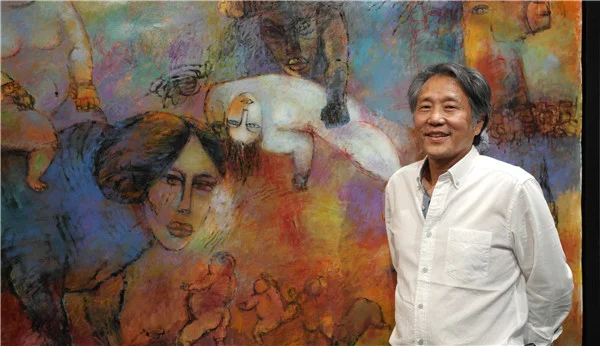The real Yang Yang must be angry. Really angry. The Chinese-born American contemporary artist whose paintings sell for as much as USD $35,000 has had his thunder stolen in recent days by another Yang Yang, a female giant panda at a zoo in Austria who has taken up the paint brush as a pastime.
And yes, while it’s true that the four-legged Yang Yang’s abstract paintings can best be described as “basic” — black splotches on white paper, reminiscent of the early scrawling of a young child — her artworks are being sold online for the not-inconsiderable sum of €490 apiece ($560 USD, give or take).
Art critics are likening Schoenbrunn Zoo’s artist-in-residence as a minimalist in the vein of American abstract expressionist Jackson Pollock, proving once again that abstract painting, if done well enough, can cross virtualluy any cultural — or species — boundary.
And while Yang Yang’s work is not a group effort exactly, it is collaborative to some extent: a zookeeper serves as her easel.
Yang Yang, 18, is a multitasker, too.
In her day job, Yang Yang has painted roughly 100 still-lifes, most of which will be posted online for sale.
She’s also a mother, having given birth to five baby pandas in all, including a set of twins two years ago.
Funds raised from the online sale of her paintings will go towards producing a picture book. Photographer Daniel Zupanc (http://www.zupanc.at) is behind the proposed picture book, which is tentatively scheduled to be published in December, just in time for Christmas.
While it’s true that sentient beings like pandas ought to be running wild and not locked in a pen — least of all in central Europe, let alone their native home in China — Yang Yang’s efforts are designed in part to raise awareness of the plight of wild pandas. Just 2,000 remain, according to conservative estimates.
Despite being a relative newcomer to the world of fine art, Yang Yang has already made a name for herself as the latest member of Vienna’s vibrant arts community.
You can’t buy publicity like this: News stories about Yang Yang’s exploits have appeared everywhere from The Economic Times in India to The Standard newspaper in Nairobi, Kenya, from BBC World in the UK to ABC News in the U.S.
Meanwhile, on the other side of the world, the original Yang Yang is making waves of his own with his “figurative paintings and sculptures of unconventional forms.” No less an expert than Lui Qi Wei, curator of the Museum of Fine Art in Shaanxi, China has described the two-legged Yang Yang’s work as combining the quality of “the Oriental mystics” with “tragic magnificence” — “tragical magnificence” being as good a description of giant panda bears as anything.
And while art snobs might take offence by comparisons of Paul Jackson Pollock (b.1912, d.1956) with a four-legged critter fond of bamboo stalks, who’s to say Yang Yang does not also qualify as “a major figure in the abstract expressionist movement . . . well known for (their) unique style of drip painting.”
According to that vast fount of human knowledge and reliable sourcing, Wikipedia, Pollock was introduced to the use of liquid paint in 1936 at an experimental workshop in New York City by the Mexican muralist David Alfaro Siqueiros. Yang Yang, on the other hand, was introduced to pen-and-ink by a zookeeper in Vienna, Austria. Is that so very different?
Pollock’s influences included Thomas Hart Benton, Pablo Picasso and Joan Miró. Yang Yang’s influences may be less rarified, but that doesn’t make them any less valid. After all, if Yang Yang could communicate in English, she might also say, as Pollock did in My Painting in 1956, “My painting does not come from the easel. I prefer to tack the unstretched canvas to the hard wall on the floor. I need the resistance of a hard surface. On the floor I am more at ease. I feel nearer, more part of the painting, since this way I can walk around it, work from the four sides, and literally be in the painting.”
Alrighty then, as pet detective Ace Ventura used to say.






